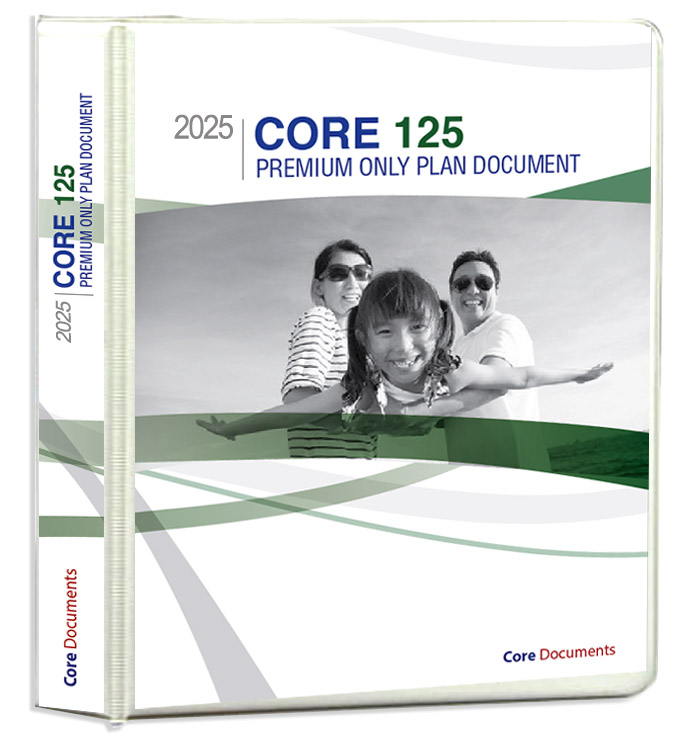Home / Blog / Coronavirus health benefit: More Section 125 employer tax savings
Coronavirus health benefit: More Section 125 employer tax savings
Companies can enjoy more tax savings while helping employees with an enhanced Coronavirus health benefit by expanding their Section 125 POP.
 Expanding Section 125 cafeteria plan options is one step in providing an updated Coronavirus health benefit.
Expanding Section 125 cafeteria plan options is one step in providing an updated Coronavirus health benefit.
Nobody likes to pay taxes, so reducing the tax bill is one of our favorite ways to increase net income. That’s especially true in this time of wide-spread financial hardship from the pandemic. Even the government looks to refundable tax credits and payroll tax deferrals to get COVID-19 relief to individuals across the country.
Coronavirus health benefit options are another way both companies and their employees can save through tax relief with an employer-sponsored Section 125 cafeteria plan.
Coronavirus health benefit options
Expand an existing Section 125 plan
Most employers providing a traditional group health plan already take advantage of pre-tax savings through a Section 125 Premium-Only Plan (POP). These plans are one of three ways recommended in a recent Forbes Business Council Post, How Pandemic-Stricken Small Businesses Can Lower Their Taxes.
Section 125 of the Internal Revenue Code allows tax-favored treatment of salary used to pay for health benefits. The Section 125 POP is the foundation of the plan for tax savings for group health insurance premiums and supplemental insurance premiums such as group term life coverage, dental and vision policies.
These premiums are paid with deductions from employee wages before taxes are calculated, in effect a choice by the employee to give up that income in favor of the benefits. Since income and payroll tax withholding is not calculated on those pre-tax dollars, the result is tax savings of up to 40% for employees. The employer saves, on average, between 8% and 10% in payroll taxes, too.
The average employer realizes a tax reduction of $115 per employee, per year, on a POP plan alone.
However, many employers still leave tax savings on the table because they neglect to offer voluntary spending accounts that get the same Section 125 tax advantage as premium dollars do.
Cafeteria plan modules
Any of these add-on modules to the basis Section 125 POP allow more choice in health coverage for employees with increased tax savings for both the employee and employer. Modules can be combined for even more savings, as shown in the table above.
Health FSA
The health flexible spending account uses pre-tax payroll deductions to pay or, reimburse participating employees and dependents for eligible medical expenses, including many over-the-counter treatments. It works alongside an employer traditional group health plan through a Section 125 cafeteria plan.
While employers may certainly contribute to a health FSA for added value, companies are not required to add a single cent to employee account to realize the payroll tax savings on dollars added by employees.
And, in earlier pandemic relief, Congress expanded the list of OTC medications eligible for coverage through health FSAs and Health Savings Accounts without a prescription.
DCAP FSA
A dependent care assistance plan (DCAP) FSA allows employees to set aside pre-tax salary deductions to reimburse eligible dependent care expenses incurred during the plan year. Again, employees realize tax savings that average 30% to 40% on those dollars while employers save 8% to 10%. That’s nearly $400 per year for each employee setting aside the maximum annual contribution.
Health Savings Account
The health savings account (HSA) is a tax powerhouse that covers medical expenses today and in retirement. It must be paired with a high-deductible health plan that meets the minimum deductible and maximum out-of-pocket limit set annually by the IRS.
These employee-owned plans are similar to the health FSA with one big difference – there is no use it or use it requirement at the end of each plan year. With an HSA, funds remain in the employee’s account, usually earning interest as the balance rolls over from year-to-year until retirement.
In addition to the expanded OTC coverage described earlier, HSAs received additional pandemic relief relating to HDHP coverage of testing and treatment for COVID-19.
Limited-purpose FSA
A limited-purpose FSA (LP FSA) is set up to work with the HDHP deductible rules of an HSA and only pays for dental and vision expenses. The employee funds the LP FSA with pre-tax dollars, just like a regular health FSA.
COVID-19 relief plan amendment
IRS Notice 2020-29 provides COVID-19 relief to Section 125 plans by allowing employers to amend a plan to make certain allowances for employees.
Mid-Year election relief
At the employer’s option, the plan may be amended to allow employees to make changes to elections made during 2019 open enrollment. This includes the type and amount of group health insurance, supplemental policies, and contributions to FSAs (including dependent care) and HSAs. Usually, mid-year election changes are not permitted unless an employee experiences a life change event that meets the qualifications for a special enrollment period (SEP).
A second option for employers is to allow a one-time expanded grace period for 2019 plan year balances to cover eligible expenses through the end of 2020. This option applies to health FSAs, limited-purpose FSAs, and dependent care FSAs.
Also, IRS Notice 2020-33 makes the FSA carryover amount eligible for an annual increase, beginning in the current (2020) plan year with a rise to $550 (from $500). This change can also be adopted within the COVID-19 plan amendment.
No group health plan? No problem.
Companies providing health insurance coverage to employees through an Individual Coverage Health Reimbursement Arrangement (ICHRA) can save with a Section 125 POP, too.
These HRAs are employer plans that reimburse employees up to a certain amount for their purchase of health insurance on the open market or through an exchange. The employer chooses the amount available for reimbursement to the employee on a monthly basis.
Chances are, most employees will have a premium higher than the amount provided by the employer. For example, if the health insurance premium is $400 each month and the employer provides $300 monthly in an ICHRA, the employee pays $100 per month on their own.
The addition of a Section 125 plan allows the employee the option of paying the full premium through the plan with that $100 treated as a pre-tax salary reduction. The average employee saves between $15 and $40 per month, while the employer realizes monthly savings between $8 and $10 per employee.
Plan document required
The only requirement set by law for an employer to establish a tax-saving Section 125 POP or cafeteria plan is that the company must have “a written plan.”
These plan documents must spell out the terms of eligibility to participate in the plan, coverage options and limits under the plan, the principals involved in sponsoring and administering the plan, rights and obligations of the participants and principals, as well as including various other stipulations and disclosures set forth by the Departments (Labor, HHS, and IRS).
Core 125 Plan Document Package
Core Documents makes it easy and cost-effective to set up a Section 125 POP or cafeteria plan. For only $99, the Core 125 Plan Document package provides everything an employer needs to establish a compliant pre-tax benefit plan:
- Section 125 Premium-Only Plan Document
- Corporate Resolution to Adopt a Section 125 Plan
- Summary plan description (SPD)
- Premium election and claim forms
- Administrative Handbook
(Visit Plan Document package includes everything an employer needs for details on each component of the package.)
Keep in mind that Core Documents’ $99 price is a one-time fee, not a recurring, annual subscription.
Easy set-up
Here is a quick look at what to do when your Core125 package arrives:
-
- Sign the Plan Document in the two places indicated.
- Give each eligible employee a copy of the SPD and election form. Election forms should be signed by employees for specifically approved deductions, returned to the employer, and kept on file.
- Conduct non-discrimination testing annually; your package includes forms to assist you in this process.
Other than that, all you have to do is:
- Keep the completed plan document package on file and available in case of an IRS audit, the DOL requesting a copy, an employee asking to view the document, or for your own personal administrative guidance.
- The document is not filed with the IRS, DOL, or any other government entity.
Plan administration
No outside administrator or software is needed to implement a Section 125 plan. A one-page summary of all plan sponsor responsibilities is included in your package.
However, for employers wanting the convenience and assurance of a 24/7/365 online plan administration service, including a benefits debit card for employees, CoreAdmin is available to our plan document clients for as low as $7 per employee, per month, and for any number of employees, even as few as one.
For more information, visit the Core Admin online administration page.

Deluxe Binder Edition
Save Big with Tax-Free Group Life & Health Insurance Premiums at Work
$99 one-time fee in PDF via email*
$149 one-time fee in PDF email* + Deluxe Binder via USPS
Core Documents provides employers with everything they need to establish an IRS- and DOL-compliant Section 125 benefits plan in PDF format for just $99. This cost reflects a one-time setup fee, not an annual charge.
For an additional $50, employers can choose the Deluxe Binder option that includes the PDF email version plus a printed plan document in a 3-ring binder (shipped via USPS).
And, for just $30 more, you can add the HSA Module for additional tax savings for the employee and the employer.
Order your $99 Section 125 POP Package Today!
Order Online
Our secure online ordering system accepts:

If you prefer to order by fax, click here.
No annual fee — Core Documents does not require an annual renewal fee to maintain your plan document package. A plan document only needs to be updated when there are changes in the plan or in the law that make it necessary. We will notify you when there are sufficient changes in the Code to require amending and restating your Plan and ask that you keep us informed when there is a change to your plan. You can amend and update your plan document anytime, at a discounted fee and only when necessary, which is the most cost-effective way to maintain it.
Fast Service — Most orders placed by 3 PM are returned via email the same day, Monday through Friday. Weekend orders are sent out Monday morning. Plan document packages are processed in the order received. During our busiest months (December, January, and February), the rush order fee (see order form) marks your document to be processed immediately.
Refund Policy: Goods and services provided by Core Documents, Inc. are non-refundable upon receipt. Orders canceled prior to shipping are subject to a fee to cover the cost of goods and services provided during the review, draft, and preparation of your order.
The Trusted Source of Affordable Benefit Plan Documents for over 20 Years.
Core Documents is the country’s leading provider of cost-effective, tax-saving benefit plan documents for Section 125 Cafeteria plans and Health Reimbursement Arrangements. The Trusted Source since 1997, thousands of satisfied agents and employer groups nationwide rely upon Core Documents for free plan design consulting services, plan document updates, ERISA Wrap SPDs, and administration services.